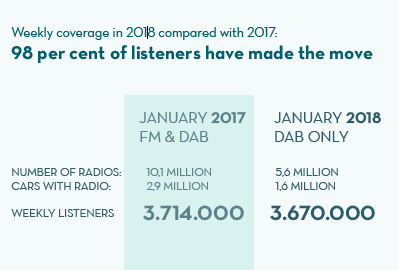The worlds first FM switch-off.
The 11th of January 2017 radio history was written in the arctic city of Bodo. Norway had become the world’s first country to start switching off national FM broadcasts and completed a Digital Switchover (DSO) for radio.
Published by Digitalradio Norge AS. Copyright 2018. All photos: Digitalradio Norge AS / P4 Radio Hele Norge AS & NRK. All figures and research data by TNS Kantar PPM survey and TNS Kantar «Digitalradioundersøkelsen»
The Norwegian DSO summed up in 8 points:
1. Teamwork essential
Norway’s radio industry has succeeded in working together in technology and digitization, while competing for radio listeners at the same time. This has been vital for achieving a digital switchover (DSO).
2. Active authorities
Norwegian authorities and politicians have actively been working with the digitization of radio since the end of the 90s. In 2011, the Storting – Norway’s parliament – decided on the shutdown of national FM stations. This was a crucial turning point for successful digitization.
3. Radio must offer more to everyone in competition with more rivals.
The urge of the Norwegian radio industry to keep radio relevant in the future has driven the DSO. National radio has increased from 5 to 31 services. Analogue broadcasting limited radio’s potential to offer richer content to the entire country in the ever harsher competition for time and attention.
4. Carefully planned switch-off
A phased switch-off region by region made it possible to run a better information campaign to prepare listeners and affected industries.
To limit listener loss for commercial radio during the switch-off year, broadcasters agreed that NRK should switch off first in most regions.
5. Listeners are loyal
On a weekly basis, 98 per cent of radio listeners have made the switchover. As expected, the decline has been greatest in the daily coverage. This indicates that listeners need time to replace all their radios.
6. Listeners prefer more chioce
Listening is spread across many more stations than before, and the new stations are growing at the expense of the old ones. In January, the new stations accounted for 34 per cent of all listening. Every week, 2.7 million Norwegians are now listening to these new services.
7. Great need for information – DAB is a little different.
A technology switchover that affects almost all the country’s inhabitants presents challenges. Using DAB radios is a bit different to using FM radios, resulting in a great need for information. Broadcasters have taken on an active role in providing information and help on the user side.
8. DAB in cars – especially demanding
Listeners have hesitated to install a new gizmo in their cars. Retrofitting aerials requires expertise. 54 per cent of all cars have DAB and two thirds of radio listening in cars takes place via DAB.
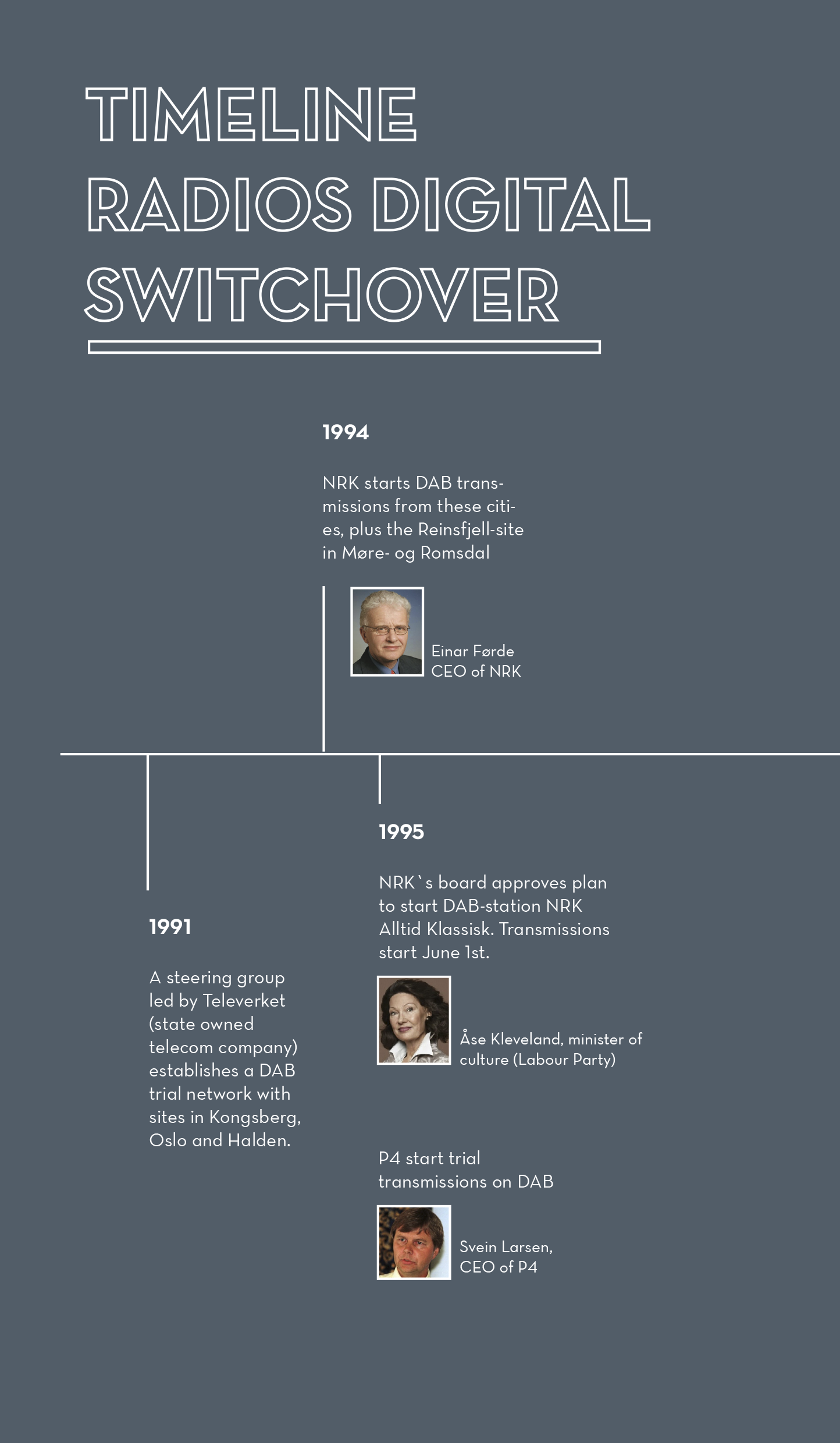
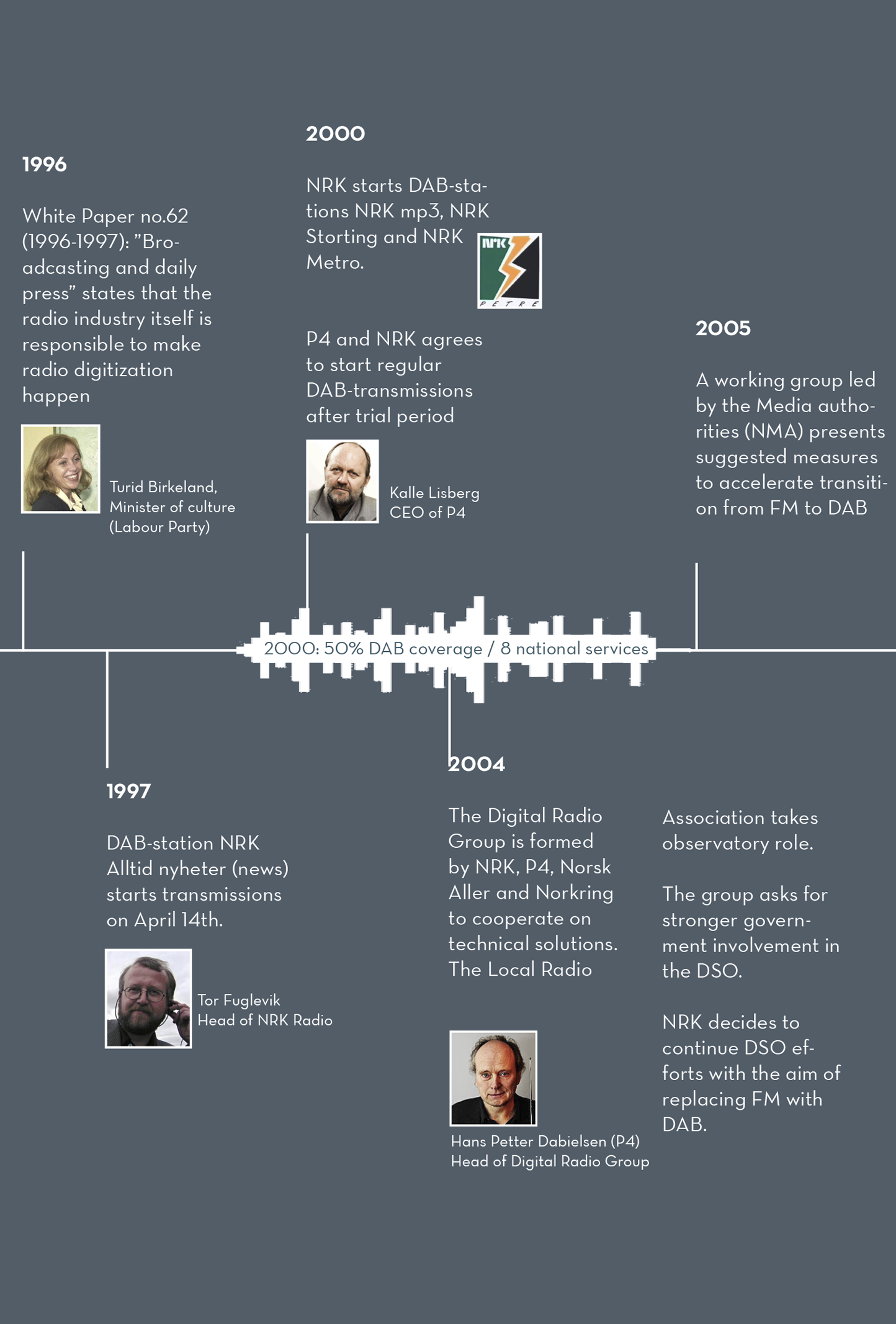
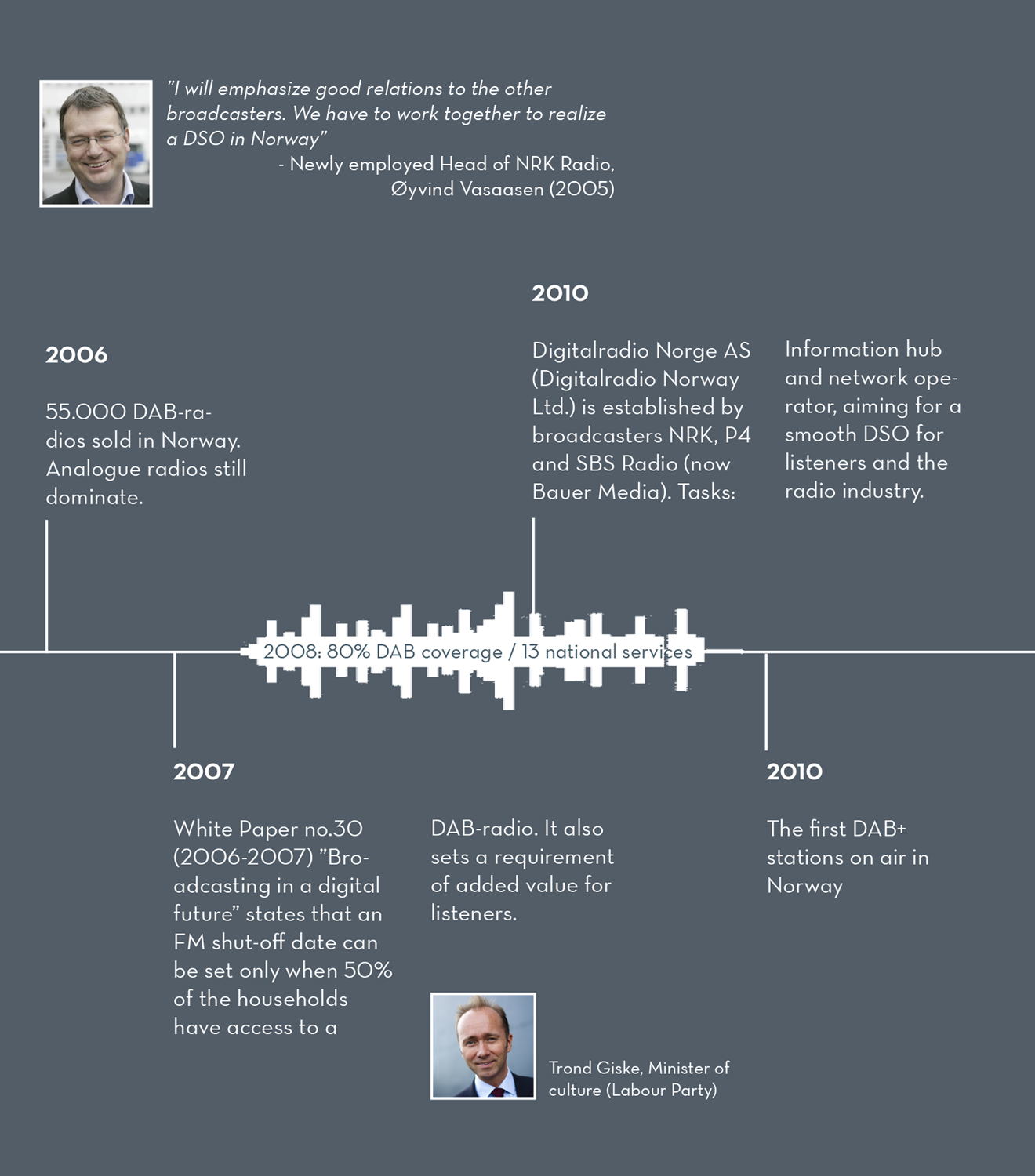
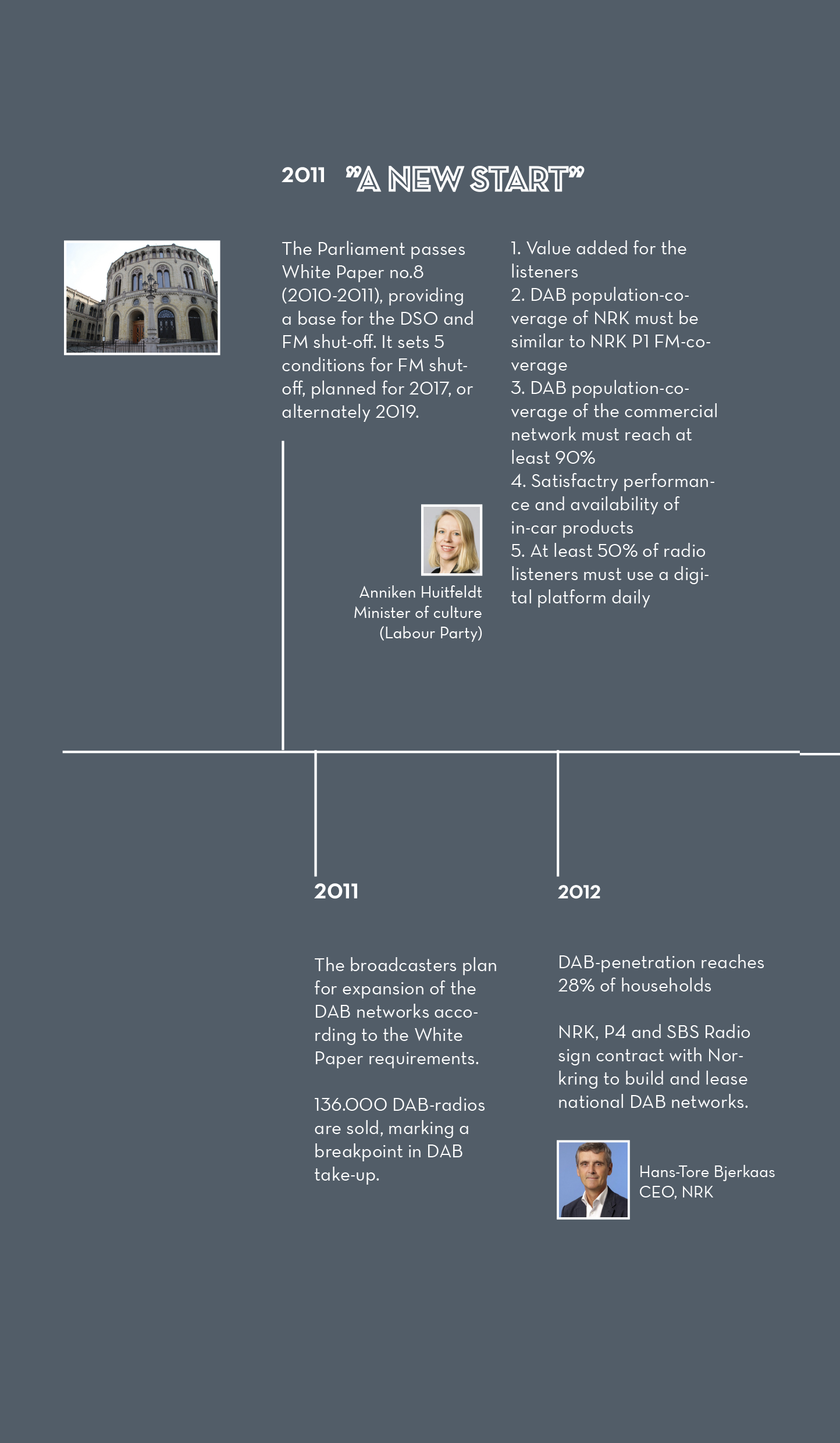
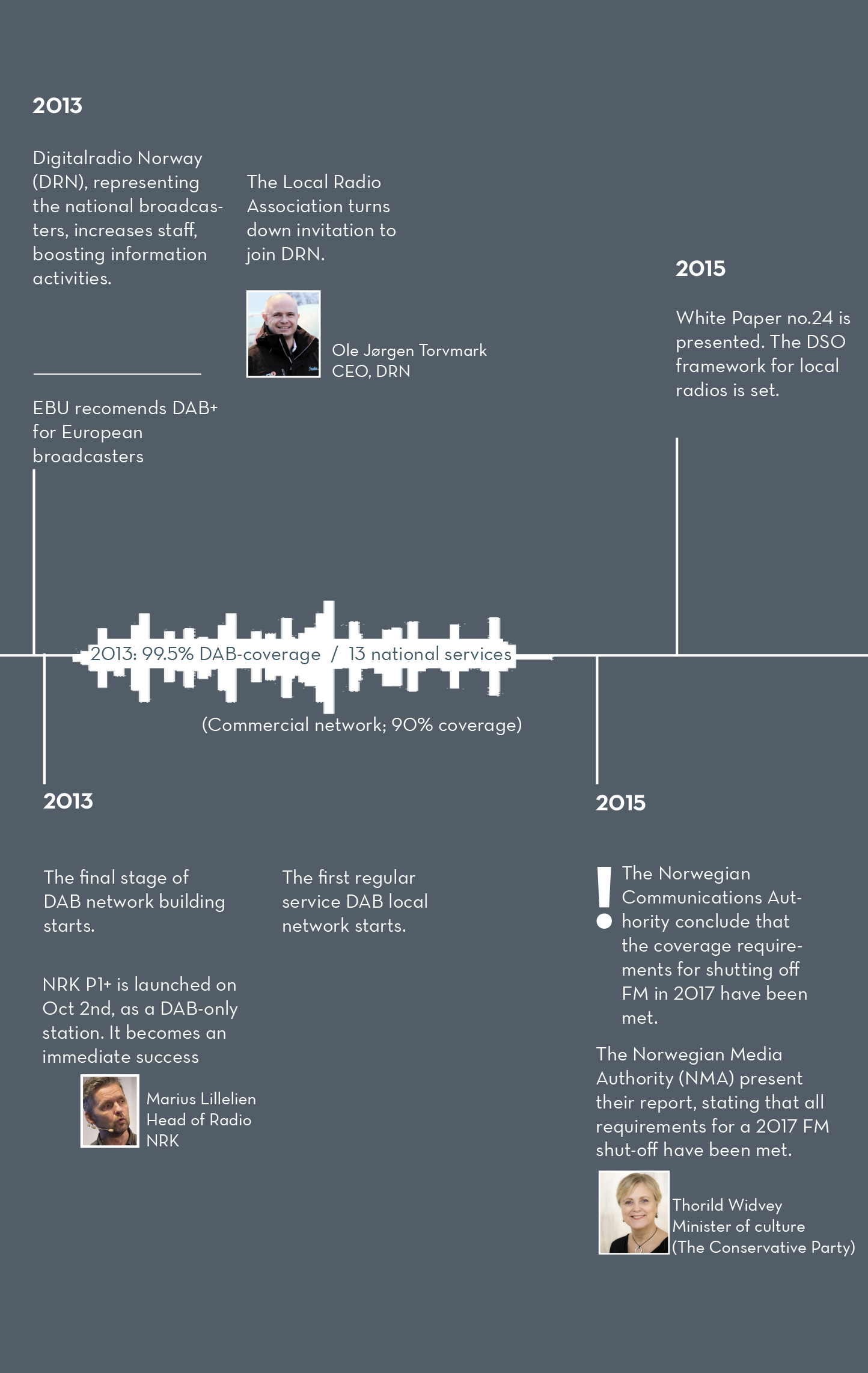
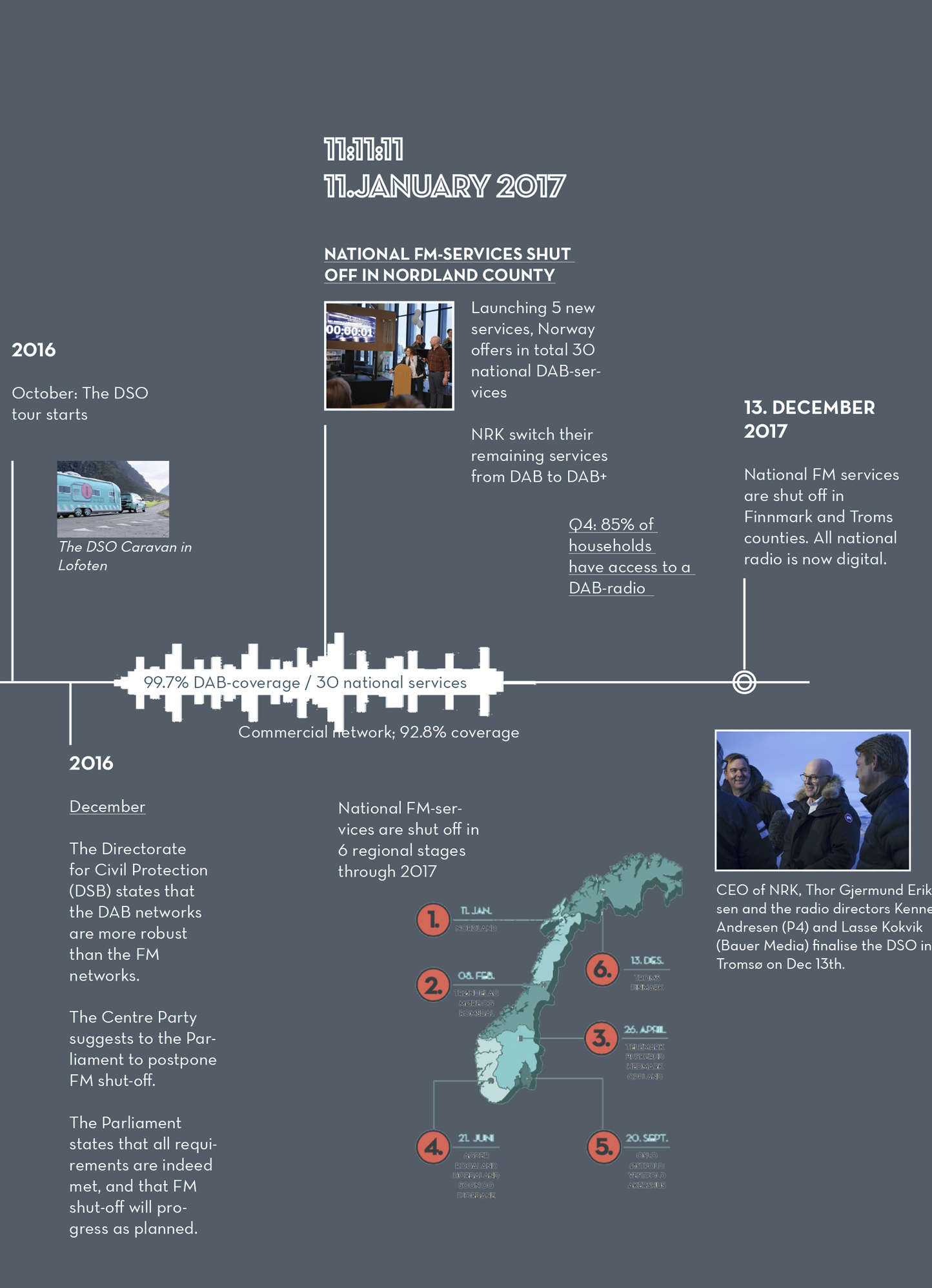

In 2011, a broad political majority decided to digitize radio. Except for the Progress Party, all the political parties voted for the digitization of radio, on the basis that radio needed the assurance of a digital future.
All sectors and industries experience major upheavals and changes through digitization and the constant development of technology. All media channels have gone through significant changes in terms of content, production and distribution. The growth of the Internet has created new distribution opportunities for the media. The increasing prevalence of smartphones has challenged the media’s business models and triggered fierce competition for the public’s attention and time. An ever-increasing media offering with more for the public to choose from leads to demands for radio services that are better adapted to listeners unique interests and taste in music.
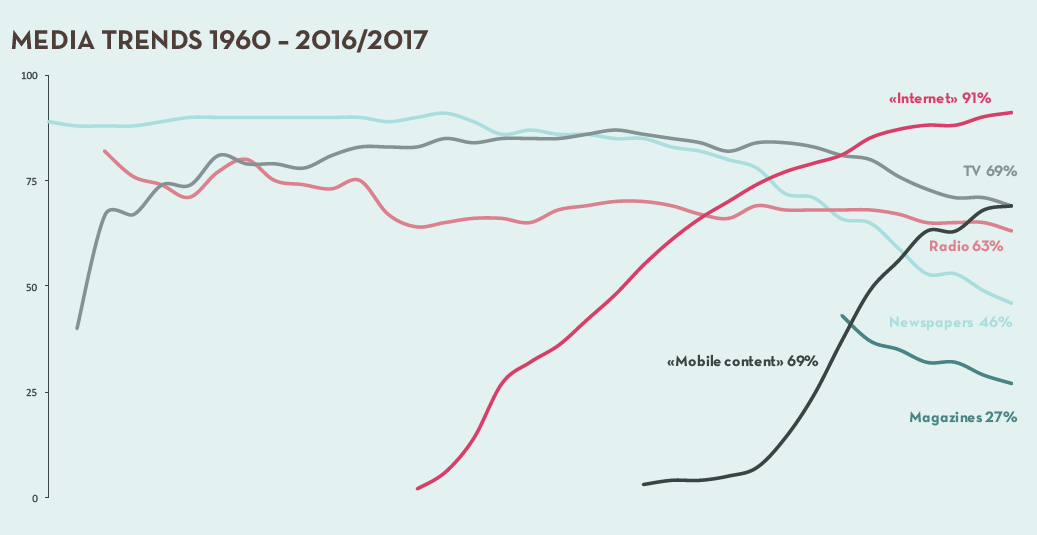
1. The need for a greater offering
The FM broadcast band is a limited natural resource. According to the Norwegian Post and Telecommunications Authority, now the Norwegian Communications Authority, it was not possible to establish more than 5 national FM networks in Norway in addition to local channels. With Norway’s topography and population structure, it was therefore impossible to offer listeners a wider national selection of services via analogue broadcasting. This limited radio’s potential in the ever intensifying competition for people’s time and attention.
2. Broadcasting is the foundation of radio.
In Norway, national radio is distributed digitally via broadcasting (DAB), the Internet and TV. Broadcasting is the backbone of the distribution that ensures the special features of radio. Broadcast radio is free of charge, freely available to everyone, everywhere, all the time. All you need to do is to turn it on.
Free
Broadcast radio has always been free of charge for listeners. This is a key feature of radio, ensuring everyone free access to content. In contrast, the Internet entails costs associated with access and use (mobile Internet).
Accessible and unlimited
Well-developed broadcasting networks that send a common signal to all receivers ensure that everyone can receive and listen to the content without restrictions. In contrast, the mobile Internet in particular has constraints related to both network capacity and volumes of data for users.
Easy
Radio requires nothing of you. It serves you a continuous stream of content according to your wishes. Radio is just “the touch of a switch” away.
The world’s best number two
All media channels and services want the users’ primary and full attention. Broadcasting has also helped to make it easy to combine radio with other tasks. Radio is a secondary medium that reaches its audience in situations where other media channels are less suitable, for example, in the car and in the kitchen.
These crucial features have enabled radio to maintain its strong position and high consumption, even though technological development has provided listeners with TV, CDs, MP3 files, Internet radio, streaming services and social media.
Despite its unique features, radio must be adapted and renewed to maintain its position in the years ahead.
3. Old FM networks and dual distribution
Costly upgrade
The FM networks were old and faced a major upgrade if they were to remain the pillar of broadcasting for a lengthy new period. This was especially true of NRK’s FM network, to ensure the uptime requirements expected of NRK. Investments in upgrading the old FM networks would have entailed high lease costs and still only five channels. Broadcasters preferred to spend the money on a modern platform that could provide the country with far more services.
Costly dual distribution
Norway has a challenging topography. To achieve national coverage, many transmitters are required. From 2014 to 2017, Norwegian national radio was broadcast over two fully developed DAB networks combined with five FM networks. A long period with full dual distribution of radio via both FM and DAB would have been extremely expensive and limited the broadcasters’ capacity to create content.
Broadcasters also distribute the services as IP streams via the fixed and mobile Internet. Although this has not amounted to a large proportion of radio listening so far, an increase is expected, which will also involve increased distribution costs.
Like the DAB networks, the FM networks were developed and operated by the transmission services provider Norkring, owned by Telenor. The broadcasters lease the various networks from Norkring. NRK’s lease costs for its DAB network are somewhat higher than the total for its old FM network, but lower than the annual lease costs for new FM networks would have been. Lease costs for the commercial DAB network are similar to the total lease cost for the two commercial FM networks. The big difference is that the DAB networks together distribute 31 national services compared with a total of 5 via FM.
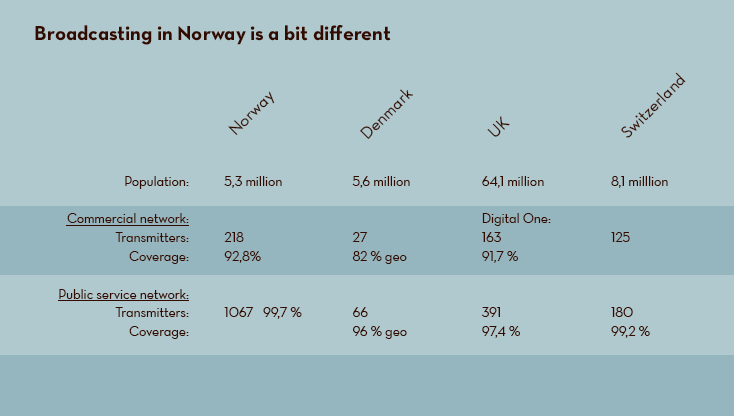
4. Improved operating conditions and predictability.
Because FM is a scarce resource, the authorities have had to regulate its use through licence allocations. This has created unpredictable conditions for the radio industry, for example when the commercial station P4 was not able to renew its licence in 2003, and similarly for several local radio stations in 2009.
For this reason, the commercial players have long wanted greater predictability in their operating conditions. Since broadcasting is no longer a scarce resource, as FM was, there is no basis for government to charge fees or impose content requirements. DAB provides enough capacity for everyone who wants and has the finances to operate radio to get a licence, as long as they have a distribution agreement with the network operator and comply with Norwegian law. In total, frequency capacity in Norway is regulated for up to 80 radio stations across the country via DAB, distributed through national, regional or local networks.
Keeping the business model
For other media channels, digitization has turned established business models upside down and created demanding and difficult transition processes. Digital broadcasting enables commercial radio broadcasters to keep their advertising-based business model, avoiding many of the challenges that newspapers, magazines and TV face.
5. Fairness in radio. More to everyone.
The same radio services for everyone
For the licence-funded Norwegian Broadcasting Corporation (NRK), the ability to reach everyone in the country with its programmes is an important prerequisite. With the capacity constraints of FM, NRK was not able to offer the same content to all parts of the country. Only when the DAB network was fully developed in 2014 did radio listeners throughout Norway have access to all NRK services, whether they lived in bustling Oslo or on the island of Andøya, in Kautokeino in the Arctic circle, or Flekkefjord in the south.
The two commercial FM networks with the stations P4 and Radio Norge had 80 and 90 per cent population coverage respectively. The commercial radio groups P4-gruppen and Bauer Media now offer 16 radio stations to 92,8 per cent of the population via the Riks DAB network.
Something for everyone
With more capacity, NRK can tailor its services to a wider variety of audiences, fulfilling its mission as a public service broadcaster more effectively.
Commercial broadcasters have long wanted to offer more content and more stations to larger parts of the country. New services have thus been launched, and pop-up services can be created to exist for shorter or longer periods.
Straight to the listener
By safeguarding radio distribution with a digital broadcasting platform that is available everywhere, free of charge, Norwegian radio will be better positioned in competition with international radio broadcasters and other media. A strong Norwegian radio industry connecting directly with its listeners, without third-party intervention in any form, is positive for Norwegian language and culture.
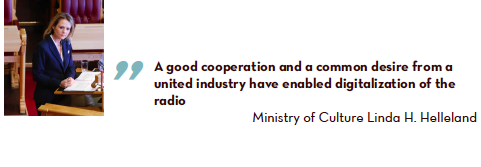
Involved industry and authorities:
The broadcasters
The extensive teamwork between national broadcasters as well as their shared recognition of the need for an FM switch-off have been vital to the digitization of radio.
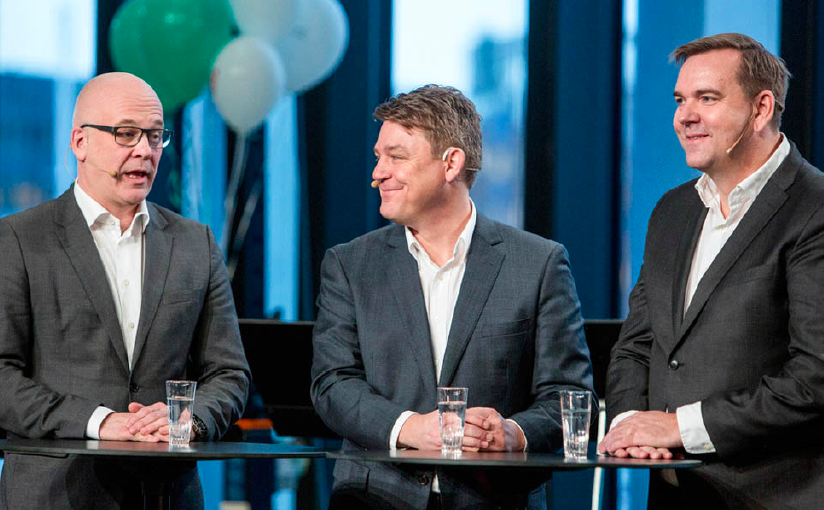
For NRK, P4-gruppen and Bauer Media, it has always been important to work together on technology, but to compete on content. For this reason, these three broadcasters established the company Digitalradio Norge (Digital Radio Norway) jointly to achieve the smoothest possible transition to digital radio. Both Norsk Lokalradioforbund (the Norwegian local radio association) and the largest player in the local radio industry were invited to participate, but chose to stay outside.
Since the establishment of Digitalradio Norge, the broadcasters have focused on investing in attractive content, new radio services, and the marketing of these.
Authorities
The Ministry of Culture – assessed the situation and prepared a plan (Report No. 8 (2010–2011) to the Storting) that paved the way for a stakeholder-controlled transition to digital radio that would safeguard both listeners and the industry.
The Storting (Norwegian parliament) – approved the digitization of radio and the Ministry’s plan.
The Norwegian Media Authority – has followed up and checked the requirements in the plan approved by the Storting, and has provided information to affected parties, especially groups with special needs.
The Norwegian Communications Authority – has followed up and checked the coverage requirements in the plan approved by the Storting.
Developer
Norkring – has built, owns and operates the national DAB networks.
Others
The electronics industry – has changed its product portfolio from FM to radios with both DAB and FM. The Storting’s decision provided trust that this commitment would be profitable.
The car industry – has gradually introduced DAB as standard in new cars, because DAB has become more common in several countries. Towards the end of the digital switchover, the car industry has also found solutions for the after-sales market.
The recycling industry – has long offered effective solutions for collecting obsolete consumer technology, and has actively followed up the DSO by informing the public that old radios should be handed in and recycled.
Digitalradio Norway
On behalf of the broadcasters

Digital Radio Norway’s mission has been to ensure a smooth transition to digital radio for all the country’s radio listeners and the radio industry. The organization coordinated the information work and led all joint activities through the ”DSO year” 2017.
The company also monitors the development of the digital radio, through Digital Radio Survey conducted by Kantar Media.
The listener – the most important of them all

The efforts of radio listeners have been vital to a successful DSO.
For many years, long before the DSO process, Norwegians have bought between 700,000 and 800,000 radios per year (according to the Consumer Electronics Trade Foundation). The Storting’s resolution to digitize radio and the steady growth in digital radio services motivated the public to start buying digital receivers instead of FM-only radios. Since the parliamentary resolution in 2011, Norwegians have bought about 5 million DAB receivers.
Upgrading car radios has been the greatest challenge for listeners. For many of them, it has been difficult and sometimes expensive to replace the entire radio or install an adaptor.
In addition, many listeners have had to spend time learning new functions and building new habits.
Local radios
Most local radio stations are still broadcasting on FM. The analogue licences last until 2022. According to figures from the Norwegian Media Authority, there were 186 active content licences for local radio on FM in 2017. In addition, 84 content licences were granted for local radio on DAB. Naturally, attitudes to the DSO vary between these. Although the digitization provides improved operating conditions for local radio as well, the limited finances in the sector make it difficult for many of the players to take advantage of this in the short term.
Government authorities have established a support scheme for the digitization of local radio, which has helped several players to get started. In 2018, the Norwegian Media Authority allocated about NOK 10 million as investment support for the digitization of local radio stations. Licences and frequencies have been granted for the development of local DAB networks in 36 of 37 regions in the national DAB block for local radio, but many have not yet started the development process.
Stakeholder-driven transition organized by the authorities.
The digitization of national Norwegian radio is the result of a thorough political process.
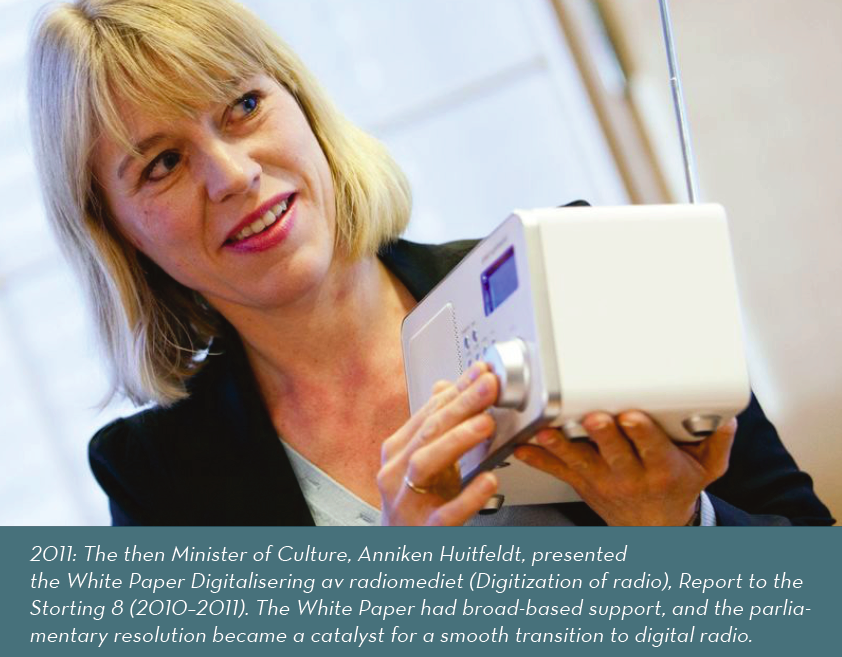
In 1997, the Ministry of Cultural Affairs presented “Kringkasting og dagspresse 1996 m.v (Broadcasting and the daily press 1996, etc)”, Report 62 to the Storting (1996-1997). This proposed that radio should be digitized in a stakeholder-driven process with DAB as the replacement technology for FM.
In 2005, a working group designated by the Ministry of Culture and Church Affairs (now the Ministry of Culture) and headed by the Mass Media Authority (now the Norwegian Media Authority), presented the report “Digitalradio i Norge” about radio digitization in Norway. The group consisted of representatives from the Mass Media Authority, the Norwegian Post and Telecommunications Authority (now the Norwegian Communications Authority), NRK, P4, Kanal 24 (now Radio Norge), Kanal 5, Norsk Lokalradioforbund (the Norwegian local radio association), Norkring and the electrical and electronics industries. The report unanimously recommended digitization of radio. The report was subsequently distributed for consultation.
The issue of digitization was explored further in the White Paper on “Kringkasting i en digital fremtid (Broadcasting in a digital future)”, Meld. St. 30 (2006- 2007).
The decision to digitize radio came in the White Paper on “Digitalisering av radiomediet” (Digitization of the Radio Medium), Meld. St. 8 (2010-2011). The White Paper emphasized that the digitization of radio could not happen without phasing out the FM network. It concluded that switch-off of the national FM networks should take place in 2017, alternatively in 2019.
Further considerations
The Ministry specified that the transition to digital radio should be stakeholder-driven. The plan was to offer P4 and Radio Norge an extension of the analogue licences for national, commercial radio in the FM network until 2017. A prerequisite for the extension was that the radio players committed themselves to ensuring the development of a commercial frequency block to cover at least 90 per cent of the population.
The Ministry assessed the change in technology from several perspectives, including the expected costs and benefits of digitization. The basis for the assessment was that radio would be digitized sooner or later and that there was no economic benefit in waiting until 2019 or later.
The authorities also wanted to safeguard the interests of local radio. In 2015, a new White Paper was published, Report to the Storting 24 (2014-2015), clarifying the framework for local radio in connection with digitization. The White Paper concluded that commercial local radio stations in the four largest cities should end their FM broadcasts at the same time as the national broadcasters. Other local radio stations were given the opportunity to continue on FM until 2022.
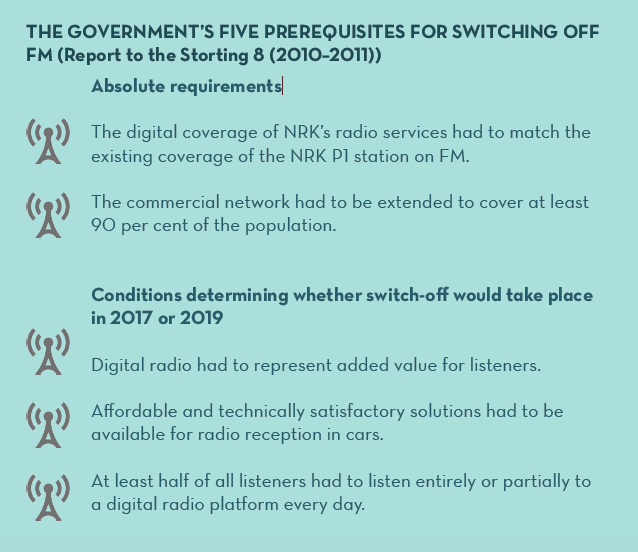
Content diversity – added value for the public
Significant content growth and more equitable distribution of radio services
With analogue radio, Norway’s radio content developed from 1 national radio station in 1933 to 5 national radio stations in 2004 (NRK P1, NRK P2, NRK P3, P4 and Radio Norge) – an extremely modest growth over 70 years. In addition, Norwegians have had access to local radio content spread throughout the country since 1982. Despite this apparent abundance of radio services, there have been large geographical variations. Only one national radio station, NRK P1, reached the entire population (99.5 per cent) via FM. And even among local radio stations, the large cities had the widest selection of services. For this reason, many Norwegians outside the most densely populated areas have only had between one and six radio stations to choose from. With the DSO, the differences between urban and rural areas has became much smaller. 92.8 per cent of the population have access to 31 national services; 99.7 per cent receive all of NRK’s programmes distributed over 15 services.
Radio has always played a key role in maintaining Norwegian language, culture and diversity. With a larger and more equitable range of services to the entire population, radio can continue to play this key role.

Transition from DAB to DAB+
In 2010, 4 new commercial radio stations were launched digitally in Norway. They were the first to broadcast in DAB+, and there would not have been sufficient capacity in the transmission network if they had broadcast in original DAB. After this, the main rule was that any new service would be launched in DAB+.
NRK gradually transferred its services from DAB to DAB+, the last ones in connection with the FM switch-off in the first shutdown region, in January 2017. Today, P4 and Radio Norge are the only stations still broadcasting in the old DAB format.
The shutdown plan – the DSO in practice
During 2017, national FM transmissions were switched off region by region, according to a shutdown plan based on an agreement between the broadcasters. The main purpose was to minimize the strain for both listeners and broadcasters.

A phased switch-off region by region made it possible to run a better information campaign to prepare listeners and affected industries than if FM had been switched off at the same time across the country. Digitalradio Norge and broadcasters could visit each region before FM was shut down there, providing local information and training so that listeners were better prepared for the switch-off.
The region-by-region switch-off would also solve an expected logistics challenge. It enabled a better supply of receivers in stores as well as imports of car adaptors which, before the shutdown, were only available in limited quantities from dealers. Inventory volumes could be concentrated on covering the regions in sequence, and experience from the first regions would give importers and dealers lead time for ordering and production for the regions that were next in line.
The same applied to workshops and other installers who could be informed about and trained in correct installation of adaptors. Listeners in the regions that were next in line might want to avoid installation queues and thus speed up digitization of their own cars.
Switching off FM region by region reduced the extent of the simultaneous decline in listeners, and created a basis for the first regions to recover before the last regions approached their shutdown date. Because a decline in listeners would have an immediate impact on revenue for the commercial players, while NRK was not affected in the same way, the broadcasters agreed that NRK should switch off first in most of the regions. The commercial players switched off two to three months after NRK – giving the population some time to obtain digital receivers. This reduced the financial risk for the commercial broadcasters to some extent.
This led to some increase in market share for the commercial players while they had FM to themselves in each region. Now that all the shutdowns have been completed, market shares are normalizing again. Read more about the results of the switch-off plan in Chapter 6.
The DSO Tour of Norway
#Radiovogna

In October 2016, Digitalradio Norge started the DSO’s Norway Tour.
The aim was to get closer to the population in the respective switch-off regions shortly before and during the switch-off date for the region’s FM broadcasts. The local presence also increased availability for local and regional media.
The DSO Caravan (vehicle) served as a local information office, press centre and workplace for employees at Digitalradio Norge.
Great need for information
DAB is a little different
Like FM, DAB is broadcasting, but still it is a little different. Many listeners have had to spend time learning new functions and building new habits. For example, scrolling through a list of services is not the same as searching for stations on FM.
Limited product range and demanding products for retrofit
For many listeners, the solution for digital radio in the car was retrofitted equipment such as DAB adaptors or radio sets with a new aerial installation. Right until 2015, the product range was limited and partly incomplete. Correct installation of the aerial was (and still is) essential for ensuring good DAB reception. The need for information about adapters and aerial installation was therefore especially great.
Different transmission networks and coverage
The division of NRK’s transmission networks into regions presented an extra challenge for some listeners. Listeners with car radios without a function for automatic frequency change (Service Following), or who have not activated this function, have lost DAB reception when they moved between two regions or listened to the wrong region in boundary zones.
At the same time, the difference in coverage between NRK’s network and the commercial Riks network created misunderstandings among some listeners.
The car industry
Radio listening in cars accounts for a significant share of all radio listening, and conversion of radios in the cars on the road was an important issue for broadcasters from an early stage.
Information activities aimed at the car industry have therefore been carried out since 2008. However, dealers and workshops in the Norwegian car industry remained hesitant in the preparations for the DSO. In 2014 and 2015, the Norwegian vehicle importers’ association Bilimportørenes landsforening wrote to the Ministry of Culture, asking for a postponement of the national FM switch-off in Norway until 2019.
At the beginning of 2017, about 22 per cent of cars on the road had factory-fitted DAB radios, while a further 10 per cent had retrofitted equipment. The retrofit market was the main reason for the increase in DAB penetration in cars to almost 50 per cent during 2017. Read more about in-car DAB trends in Chapter 6.
Early on, it became clear that the DSO would be a major challenge for the car industry. Through Digitalradio Norge, broadcasters therefore worked actively to ensure that the industry (players) had up-to-date information at all times.
Several actions were taken in addition to contributing to the supply of affordable products of good quality.
These actions ensured that all Norwegian motorists who wanted to upgrade their car radio to DAB+ when national FM broadcasts were switched off, could do so. Universal adapters designed for self installation were on sale throughout Norway, and installation services were available for those who did not want to install the equipment themselves.
The Norwegian Car Radio Promotion initiative took care of reception features and ease of use for the products that were part of the project. These were also the best-selling car adaptors in 2017.
Environmental aspects
An extensive change in technology such as the radio switchover means that large numbers of radios must either be upgraded or replaced. Norway has a well-developed system for recycling electronic waste. When the radios are handed in, 90 per cent of the components will be recycled into new materials, while 9 per cent will be used for energy recovery. This means that 99 per cent of the products are recycled.
Old radios make up a small volume of all the electronic and electrical waste collected annually.
THE MESSAGES
1) Not all old radios need to be replaced. Many can be still be used with a DAB+ adaptor.
2) All radios that will no longer be used, should be recycled.
Digitalradio Norge had a close dialogue with the recycling companies and the electronics industry to get these messages out to the public, and to and to make sure the information was correct.

OLD RADIOS
The launch of the FM switch-off in 2017 triggered great demand for adaptors for upgrading both car and home radios. Far more units for home radios were sold than had been forecast, and it became clear that Norwegians had great affection for their old radio heirlooms. In the Radiovogna roadshow vehicle, a Tandberg Huldra 10 from 1967 was displayed with an adaptor installed. Many of those who contacted Digitalradio Norge had questions about the use of adaptors for upgrading old radios.
Commitment and criticism
Such a far-reaching technological change, which affects and demands something from all radio listeners, is bound to spark engagement, scepticism about change and a critical look at the project from the media, organizations and engaged individuals.
In addition, radio is extremely important to the population and has a strong role in terms of both history and emergency preparedness.
Openness and fact-based information about the switchover process has been vital to the radio industry. Throughout the changeover, the industry has worked to achieve a high level of accessibility and openness.
Debate and critics
The over 20-year long transition to digital radio has been through a number of political processes and public debate. Although the White Paper in 2011 was approved by all the parties except the Progress Party, political debate about the DSO continued until the FM shutdown began.
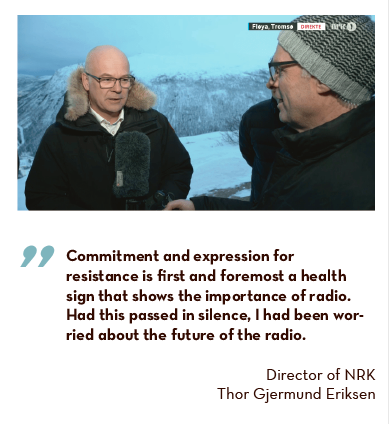
The final debate in the Storting took place on December 6, 2016. In addition to the political environment, the most prominent critics of radio digitization, DAB and the FM shutdown came from the ICT industry and the local radio sector. Criticism has been expressed through media reports, consultation statements and complaints to the EFTA Surveillance Authority (ESA). The criticism fuelled uncertainty among listeners about whether the DSO would really happen, with resulting delays in sales of receivers. Towards the end of the DSO, many of the discussions shifted to groups of active individuals on social media.
The main reason for digitization was the radio industry’s urge to keep radio relevant and robust in the future. The technology transition was not carried out to win listeners in the short term, but to take care of radio listening in the long term. The results of the DSO will emerge further ahead in the future, but it is still possible to see some of the main features of the switch-off year of 2017 and some changes in radio use.
Expectations of decline and changes
As the shutdown approached, the Digital Radio Survey showed that a number of listeners wanted to wait until FM had in fact been switched off before they converted to digital. The radio industry therefore expected a decrease in the number of listeners right after the FM shut-off dates. At the same time, growth in the new services were predicted at the expense of the established stations that had previously had FM distribution.
When the decline in daily listening is greater than the decline in weekly listening, the reason is probably that the public is listening to radio in fewer situations than in the past. Not everyone has replaced their old radio sets or established new digital listening habits yet.

The switch-off year saw sales of more than 2 million DAB radios
99% of Norwegian households have access to digital radio
Access to DAB has grown steadily and sharply with more than a fourfold increase during the 6 years since the White Paper in 2011:
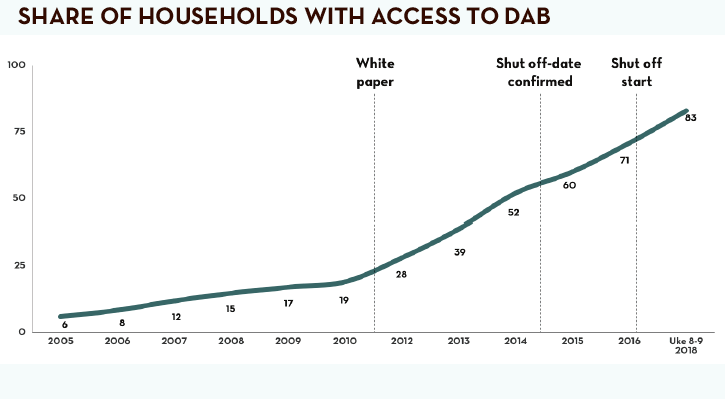
Access to new content changes radio habits the most
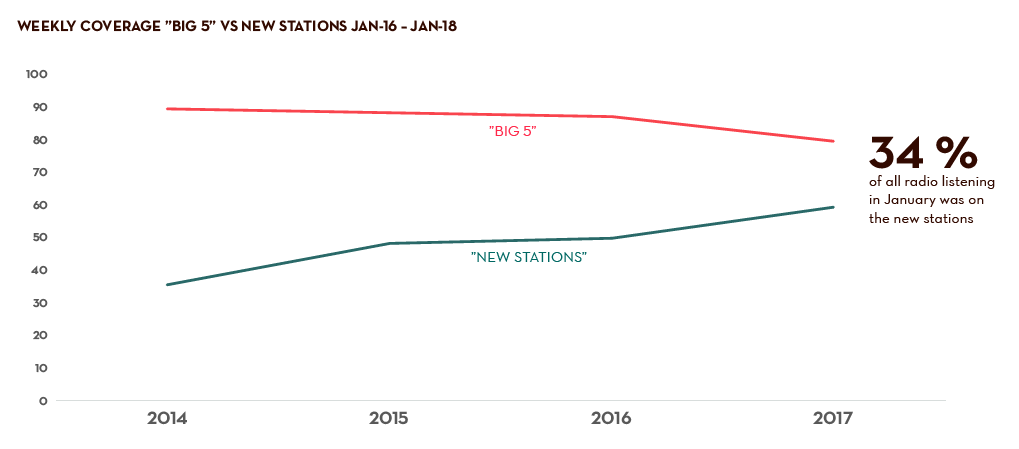
Listening to new stations Listening is spread across many more services than before, and the new stations are growing at the expense of the larger ones. In January, the new services accounted for 34 per cent of all listening. These had little or no distribution on FM. An aim of the DSO was to offer audiences more content and more choice. Many stations are growing, but total daily listening has declined. Many people have still not replaced all their FM radios, especially in the last and most densely populated switch-off regions.
A new radio landscape
The national market for radio has expanded from 5 to 31 services in a few years. Stations such as NRK P1+, Radio Rock, P5 Hits, P10 Country, Radio Vinyl and Radio Topp 40 are among the newcomers in recent years that have had great success
The transition to digital radio has also created greater opportunities for seasonal stations or content. In existing or completely new pop-up stations, broadcasters can present content to reach a targeted audience during a specific time period.
In recent years, P4-gruppen has changed the station P7 Klem to P7 Klem – the Christmas station, during the Christmas season, dedicated to Christmas music.
During Christmas 2017, Bauer Media created its own pop-up Christmas station.
Market share
The FM shutdown of P4 and Radio Norge two to three months after NRK’s channels, in the most densely populated regions, gave the commercial players a somewhat higher market share in 2017. At the beginning of 2018, the relationship between the broadcasters seems to be normalizing again.
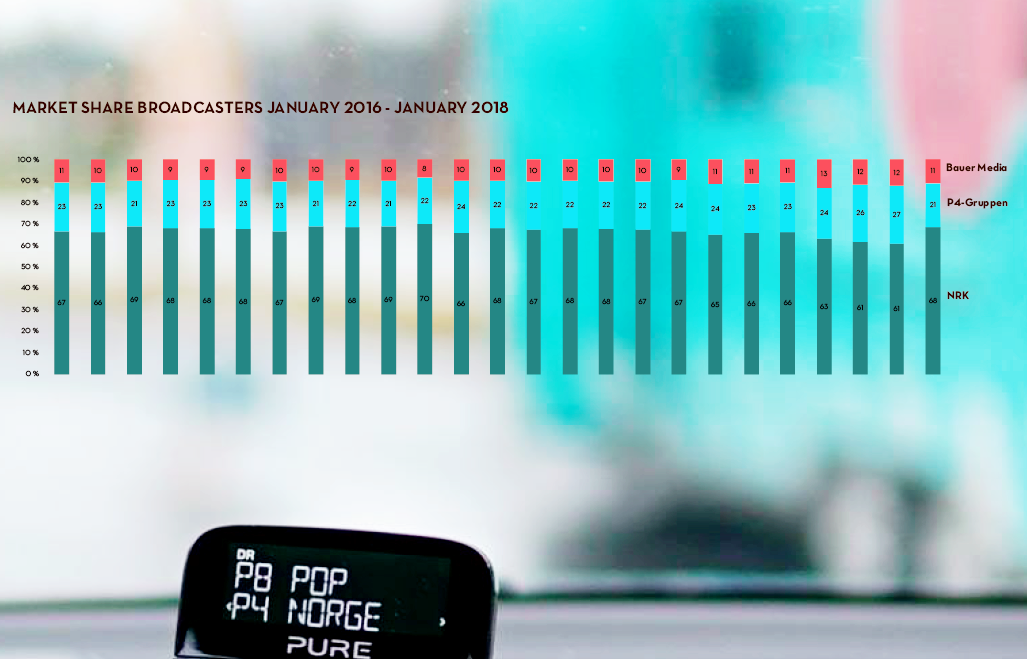
Development in the first switch-off regions
The radio market is gradually normalizing
In the regions that switched off first, 14 months have now passed since the FM broadcasts disappeared. Figures from the Digital Radio Survey show that the proportion of households with DAB radios is highest in the regions that have been digital the longest.
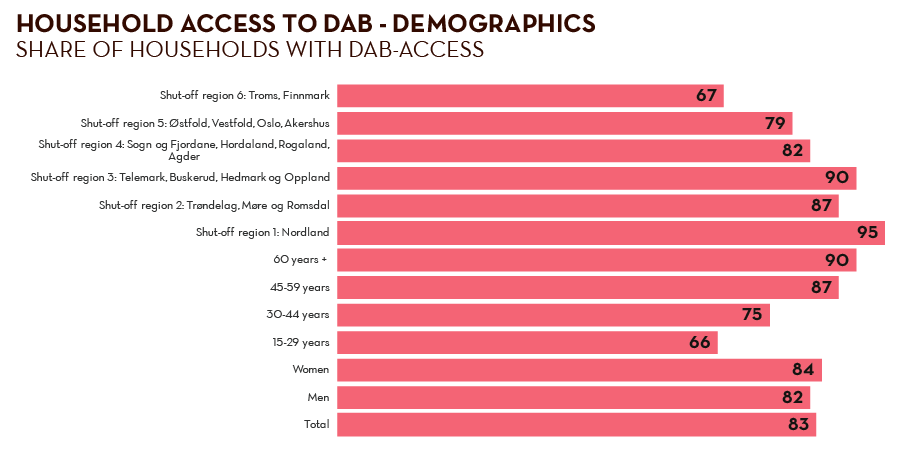
During the past 15 months, Norwegians have bought 2.4 million DAB radios. This corresponds to more than one DAB radio per household. Of the 5.6 million radios, 3.1 million are in Norwegian homes, 1.6 million in cars, while the rest are typical leisure radios in cabins, boats, etc.
Most listeners have chosen to replace FM with DAB, but in the last year we also see some growth in radio via the Internet and digital TV.
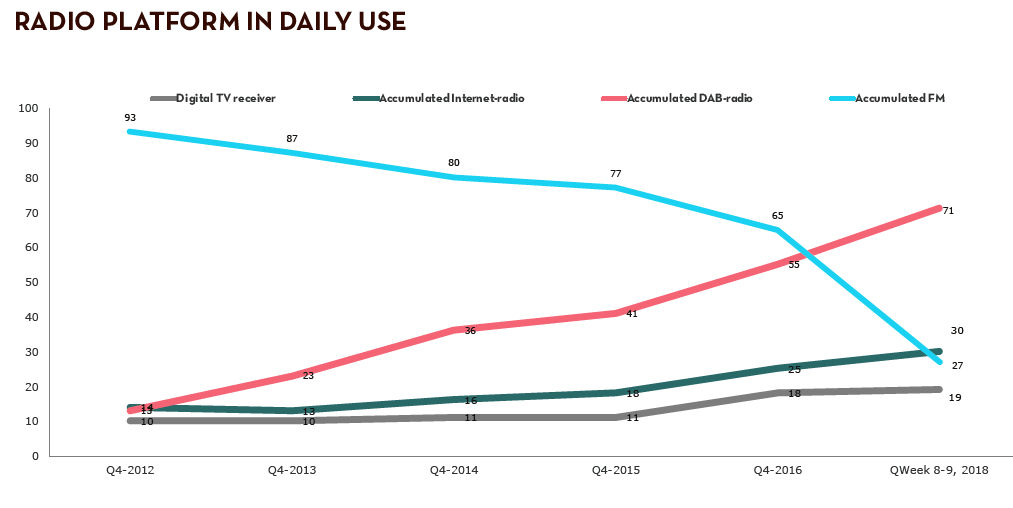
Both the school winter holidays and the Olympics took place in week 8 – 9. Historically, listening patterns show higher use of Internet radio during such periods.
Half of radio listeners use a DAB radio at home during a radio day, while 43 per cent use DAB in the car. This does not include listening via the Internet and digital TV. Eight per cent of radio listeners listen to FM at home and 20 per cent to FM in the car. Use of FM involves listening either to local or to foreign stations.
Digital use among radio listeners began to grow significantly after the 2011 White Paper, and the graph has naturally become even steeper in the last two years.
Only 14 per cent of daily radio listeners use FM only. After the switch-off of national FM broadcasts, this implies listening to local radio or foreign radio.
Still a way to go
In the Digital Radio Survey of February 2018, Norwegians state that they have 5.6 million DAB radios and 4.7 million FM-only radios. These radios are now distributed fairly evenly in Norwegian households, compared with the distribution of FM-only radios in 2016. However, there is still a way to go before DAB achieves similar distribution. Alternative digital platforms partially weigh up for this situation.
AD REVENUES STABLE TROUGHOUT DSO
REVENUES. NORWEGIAN RADIO MARKET

Strong growth in cars with DAB
In February 2018, 54 per cent of Norwegian private cars had a DAB receiver. Over a 15-month period, almost as many motorists have converted as the total number of conversions during all the years before the FM shutdown. Naturally, most of the conversions during this period were based on aftermarket solutions. Of new private cars sold in Norway, virtually 100 per cent are delivered with DAB radio.
Daily radio listeners have bought DAB for the car to a greater extent than the general population. Of total car radio listening, about two-thirds takes place with DAB.
DAB adaptors
As the first country in the world to switch off national FM broadcasts, Norway is also the largest market for the new product group of DAB adaptors. This has caused some teething troubles on the product side. There has been a great need for information about how to install them and use them correctly.
Among those who have a DAB adapter, 43 per cent say that they are satisfied or very satisfied, 25 per cent are neutral, while 31 per cent are dissatisfied or very dissatisfied.
Most of those who own DAB adapters state that they are user-friendly, but that they do not necessarily fit particularly well into the car. The number of people who think that adapters provide good radio reception is about the same as those who think the opposite. We see the same pattern in response to the statement that the adapters are difficult to install.
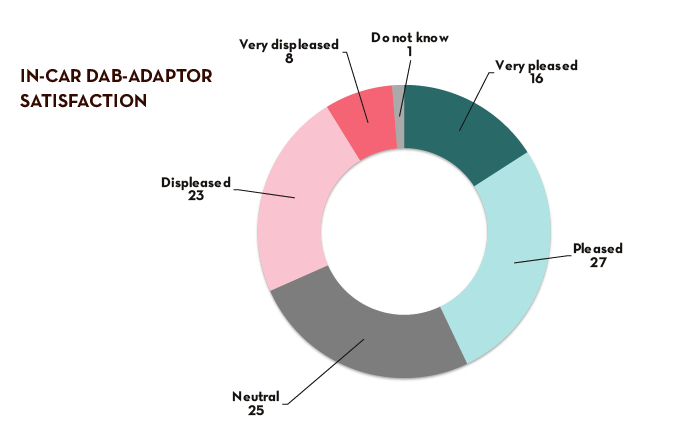
Motorists without DAB
Those who do not yet have DAB in their car but used to listen to national radio in their car every day before the FM shutdown state that, in the absence of national channels, they mainly listen to local radio or music via streaming or CD. Some choose silence, while others stream radio or podcasts via their mobile phone.
9 per cent plan to upgrade the car
Of those who do not have DAB in the car, 19 per cent are planning to buy in-car DAB. This level is slightly higher compared with previous surveys on plans to buy DAB in general.
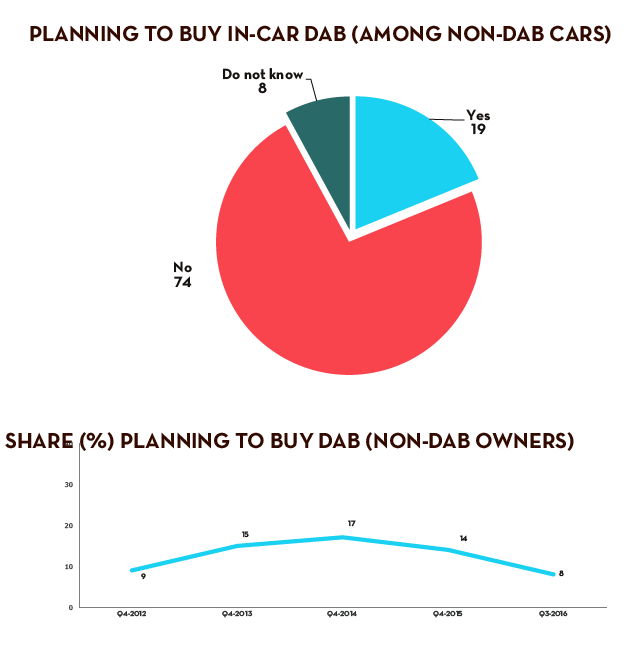
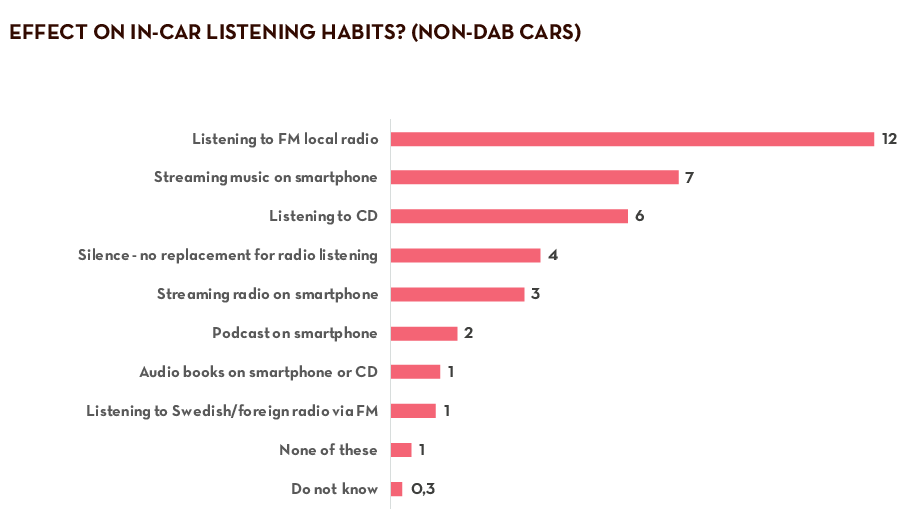

More DAB radios
As discussed in Chapter 6, the numbers of listeners and the sales figures show that radio listeners are loyal and have made the move to digital platforms. To achieve an increase in the time spent listening to radio, listeners need time to replace more of their radios, or establish other habits for digital listening.
Traditional broadcasting
Norway is the world’s most modern radio nation with full digital distribution of national radio stations. FM has been replaced by several digital platforms: DAB, IP/Internet and digital TV. Of these, DAB is the largest and the platform with the greatest growth in recent years, although Norway is perhaps a world champion in Internet access and the prevalence of mobile phones, tablets and computers. The Digital Radio Survey shows that most listeners prefer a traditional radio.
The Internet advances into typical radio situations
However, we may be on the threshold of a faster change and new opportunities for increased use of radio via IP in the more typical radio situations. Connected cars with Internet-based multimedia and smart speakers – voice-controlled speakers for the home – open completely new opportunities and potential challenges for radio.
With digital broadcast networks, Norway has ensured that in the future radio will be able to reach the entire population with services in Norwegian, without gatekeepers, paywalls or capacity constraints. For the new IP-based services in the car and home, this cannot be taken for granted. Aggregators are indispensable for creating user-friendly services, but who should have these roles? The radio industry itself, or third parties, such as TuneIn, Apple, Google, or Facebook? From the digitization of other media, we have seen how often distribution and control have ended up in the hands of exactly these companies.
The DSO continues
Norway is the world’s first country to fully digitize national radio. With a broad offering of services and wide-coverage national digital broadcasting, the radio industry believes it is better equipped to face competition and challenges in the years ahead.
Other countries are following suit.

-Graham Dixon, President, European Broadcasting Union.
Norway is far from alone in investing resources in DAB and digital radio. Today, about 470 million people have access to DAB broadcasts in a total of 41 countries, distributed via 2252 different radio stations.
For more information on this, go to the WorldDAB website.
